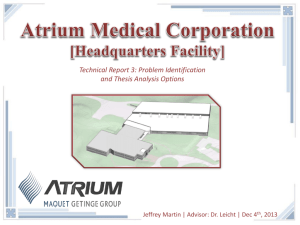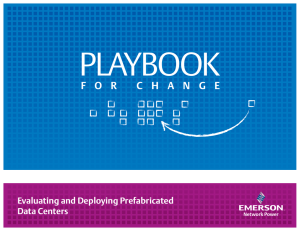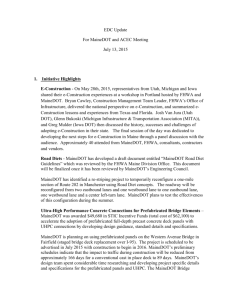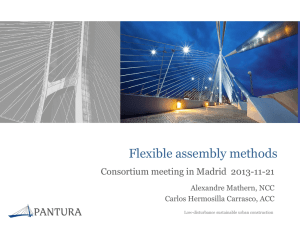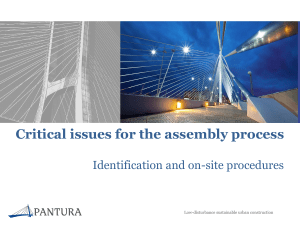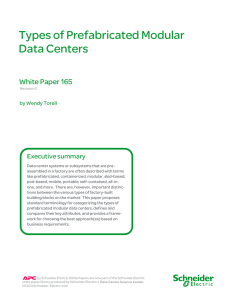EXECUTIVE BRIEF Prefabricated Data Centers: Are They Right for You?
advertisement
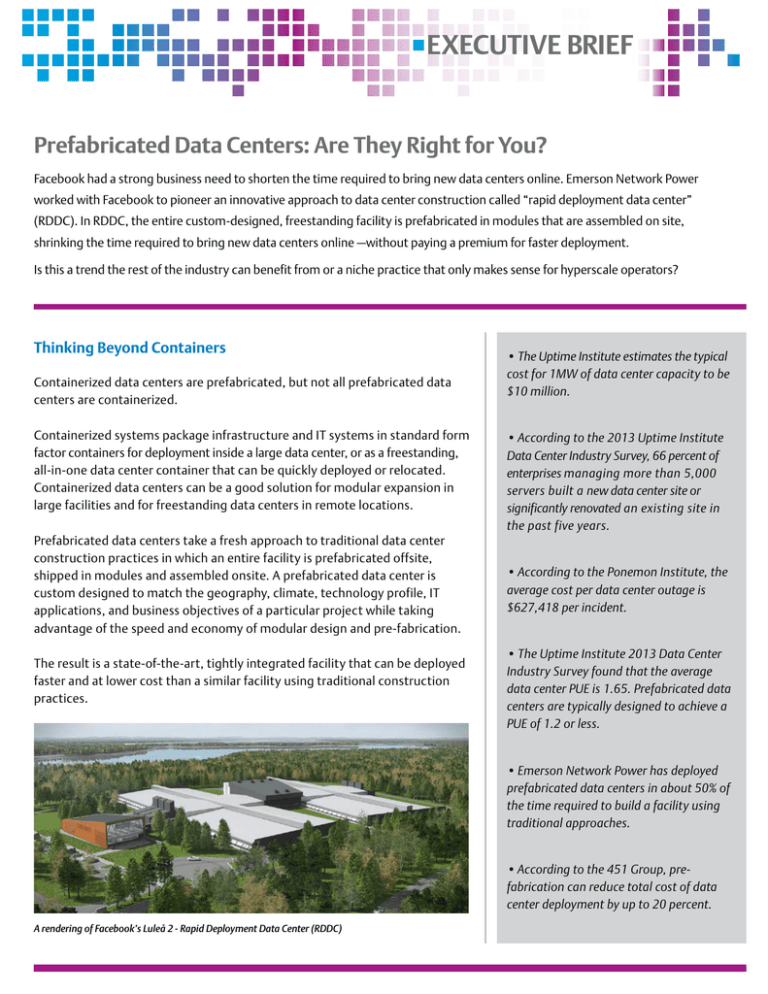
EXECUTIVE BRIEF Prefabricated Data Centers: Are They Right for You? Facebook had a strong business need to shorten the time required to bring new data centers online. Emerson Network Power worked with Facebook to pioneer an innovative approach to data center construction called “rapid deployment data center” (RDDC). In RDDC, the entire custom-designed, freestanding facility is prefabricated in modules that are assembled on site, shrinking the time required to bring new data centers online —without paying a premium for faster deployment. Is this a trend the rest of the industry can benefit from or a niche practice that only makes sense for hyperscale operators? Thinking Beyond Containers Containerized data centers are prefabricated, but not all prefabricated data centers are containerized. Containerized systems package infrastructure and IT systems in standard form factor containers for deployment inside a large data center, or as a freestanding, all-in-one data center container that can be quickly deployed or relocated. Containerized data centers can be a good solution for modular expansion in large facilities and for freestanding data centers in remote locations. Prefabricated data centers take a fresh approach to traditional data center construction practices in which an entire facility is prefabricated offsite, shipped in modules and assembled onsite. A prefabricated data center is custom designed to match the geography, climate, technology profile, IT applications, and business objectives of a particular project while taking advantage of the speed and economy of modular design and pre-fabrication. The result is a state-of-the-art, tightly integrated facility that can be deployed faster and at lower cost than a similar facility using traditional construction practices. • The Uptime Institute estimates the typical cost for 1MW of data center capacity to be $10 million. • According to the 2013 Uptime Institute Data Center Industry Survey, 66 percent of enterprises managing more than 5,000 servers built a new data center site or significantly renovated an existing site in the past five years. • According to the Ponemon Institute, the average cost per data center outage is $627,418 per incident. • The Uptime Institute 2013 Data Center Industry Survey found that the average data center PUE is 1.65. Prefabricated data centers are typically designed to achieve a PUE of 1.2 or less. • Emerson Network Power has deployed prefabricated data centers in about 50% of the time required to build a facility using traditional approaches. • According to the 451 Group, prefabrication can reduce total cost of data center deployment by up to 20 percent. A rendering of Facebook’s Luleå 2 - Rapid Deployment Data Center (RDDC) Key Considerations for Prefabricated Data Centers Speed of Deployment The biggest driver of the move to prefabricated data centers is speed of deployment. Prefabricated data centers cut months off the time-to-deploy and should be strongly considered by any organization seeking to accelerate data center deployment. Scalability Because prefabricated data centers take a modular approach to design and fabrication, they are inherently scalable and may create opportunities to delay some portion of the capital investment required for a new data center until additional capacity is required. Design Flexibility Prefabricated data centers are custom designed to a site and have no inherent limitations in terms of functionality or aesthetics. Performance In a prefabricated data center, all systems are designed and configured in concert, resulting in a tightly integrated facility that can meet the highest standards of availability and efficiency. Assembly in a factory-controlled environment enables more control over the fit, finish and quality of workmanship and supports more thorough pre-testing and optimization prior to delivery. Cost One of the most powerful benefits of a prefabricated data center is that it does not require the value of faster deployment to be weighed against the additional costs commonly associated with faster delivery. Prefabricated data centers leverage economies of scale and streamlined processes made possible by offsite assembly to enable faster deployment at a lower cost. The economics of a prefabricated data center are so attractive that they can change the cost-benefit analysis regarding expanding an existing facility versus a new build. A prefabricated data center may enable an organization to move a data center to a more desirable location at about the same cost as expanding and updating an existing facility. What You Need to Succeed While prefabricated data centers offer significant advantages over traditional approaches, execution can be an issue for vendors that lack the necessary expertise and capabilities. Here’s what to look for: Engineering as a core competency Designing a prefabricated data center requires deep engineering and data center expertise. The better the engineering team working on your solution, the more likely you are to achieve objectives. Look for vendors with experience in this category. Breadth of product offering and vertical integration Having to bring together multiple third parties to develop a solution negates many of the benefits of prefabricated data centers. Look for vendors that can supply multiple data center systems as part of the prefabricated package while integrating best-of-breed products from other vendors as required. Combining engineering expertise with industry leading products in a vertically integrated solution enhances the cost benefits of pre-fabrication. Project management and maintenance services Identifying a lead vendor that can be accountable for the entire project is a necessity. Ongoing maintenance is also simplified with a vendor that can deliver an integrated service model. Share this document on: EmersonNetworkPower.com Emerson, Emerson Network Power, and the Emerson Network Power logo are trademarks or service marks of Emerson Electric Co. All other names, product brands, and logos are the property of their respective owners. ©2015 Emerson Electric Co.
